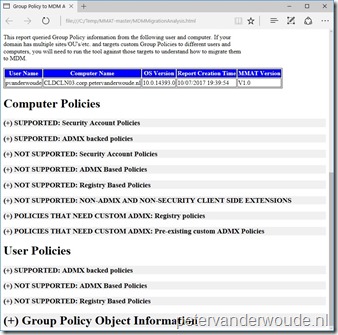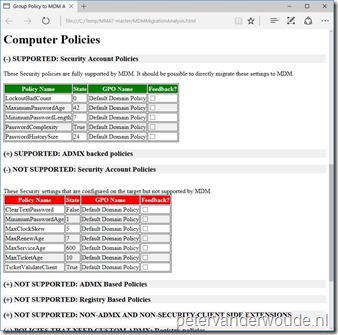This week something completely different compared to the last few weeks, maybe even months. This week is all about creating awareness for the MDM Migration Analysis Tool (MMAT). MMAT is created to make the transition to MDM easier. At Ignite it also got some attention and I thought it would be good to add some more attention to it. Even though it already exists for a while. I’ll start this post with an introduction to MMAT, followed by the usage of MMAT. I’ll end this post with example results of MMAT.
Introduction to MMAT
Before looking at the technical transition to MDM policies, via Microsoft Intune (hybrid or standalone), or any third-party MDM, start with MMAT. MMAT is a tool created by Microsoft to help with the technical transition from Group Policies to MDM policies. It’s mainly created to save administrators time, as there is not a one-on-one mapping available for MDM policies with Group Policies. MMAT will determine which Group Policies have been set for a targeted user/computer and cross-reference against its built-in list of supported MDM policies. MMAT will then generate both XML and HTML reports indicating the level of support for each Group Policy in terms of MDM equivalents. In a bit more detail MMAT basically works in the following three stages:
- In the first stage it determines which GPOs have been applied to the targeted user/computer, by using RSOP (via WMI). After that It will filter out GPOs that are marked as not enabled, or with access denied;
- In the second stage it uses PowerShell, for each GPO, from the first stage, to get the GPO XML from the server. It will store that information in GPOReport-{GPOGuid}.txt files, which are stored in, by default, the current directory;
- In the third stage it invokes MdmMigrationAnalysisTool.exe. That consumes the
GPOReport-* files and compares them against MDMPolicyMapping.xml. At the end it generates the final XML and HTML reports.
Note: MMAT only does a best-effort analysis.
Using MMAT
Now let’s have a look at how easy it is to use MMAT. However, before doing that let’s first have a look at the prerequisites. The Remote Server Administration Tools (RSAT) must be installed on the device running MMAT. RSAT is available via the following URLs:
- Windows 7: https://www.microsoft.com/en-us/download/details.aspx?id=7887;
- Windows 8: https://www.microsoft.com/en-us/download/details.aspx?id=28972;
- Windows 8.1: https://www.microsoft.com/en-us/download/details.aspx?id=39296;
- Windows 10: https://www.microsoft.com/en-us/download/details.aspx?id=45520.
After installing RSAT, use the following steps to “install” and run MMAT.
| 1 | Download MMAT as ZIP from: https://github.com/WindowsDeviceManagement/MMAT; |
| 2 | Unzip MMAT to C:\Temp (example location); |
| 3 | Open Windows PowerShell and use Run as administrator;. |
| 4 | Adjust the directory: Set-Location C:\Temp\MMAT-master; |
| 5 | Adjust the execution policy: Set-ExecutionPolicy Unrestricted -Scope Process; |
| 6 | Adjust the verbose preference: $VerbosePreference=”Continue”; |
| 7a | Run MMAT: .\Invoke-MdmMigrationAnalysisTool.ps1 -collectGPOReports -runAnalysisTool; |
| 7b |
Additional parameters for running MMAT:
|
Results of MMAT
After running MMAT it’s time to have a look at the results. By default the reports and logs are stored in the same directory as MMAT. The actual readable results are available in MDMMigrationAnalysis.html. Below on the left is an example of the high-over policies listed in MDMMigrationAnalysis.html for the computer and the user. Below on the right is an example of some more details about, in this example, supported and not supported security account polices. Especially the example on the right clearly shows that these results are only an initial check to see which Group Policies can be configurable via MDM policies. Nothing more.
 |
 |
Note: Before interpreting the results, make sure to be fully aware of the documented caveats and warnings.
More information
For more information about MMAT, please refer to the documentation about MMAT on GitHub.
Hello Peter
just one Question, properly stupid but often heard: Do i have to install all of the 21 RSAT for the MMAT or are there only one or a few Tools of the RSAT Package needed?
Hi ATR,
I haven’t looked at that specifically, but I would expect the tools related to GPO at least. Before FOD installation it was all or nothing 🙂
Regards, Peter
Hi,
once you have the XML report – is there way to import that info into InTune or do you have to create each policy individually and use the XMl for reference to each setting?
Thanks
Hi Sam,
This tool only provides an analysis. Nothing more, nothing less.
Regards, Peter
THE github link is now broken?
Hi touseef,
You are correct. That doesn’t matter, as there are configuration options within Microsoft Intune itself.
Regards, Peter
When I follow the link to GitHub I get a 404 page not found. Has this been moved or has something else taken over from it?
Hi Tony,
You now have Group Policy analytics directly integrated in Intune.
Regards, Peter